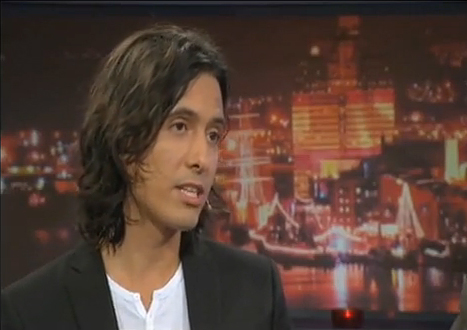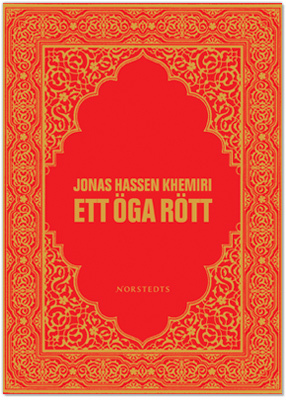Caught between 'kanelbullar' and baklava.
Jonas Hassen Khemiri’s debut novel “Ett öga rött” (One Eye Red) has been called a “spicy linguistic picnic.” The book was one of the first times "rinkebysvenskan" met mainstream Sweden. We met with the author two years after his book was published.
-
 Jonas Hassen Khemiri on ‘Carin Hjulström 21:30’ /Still from YouTube
Jonas Hassen Khemiri on ‘Carin Hjulström 21:30’ /Still from YouTube -
-
This interview by Eva Stenskär was originally published in Nordstjernan in print in 2005.
-
 Jonas Hassen Khemiri, Jan Eliasson on ‘Carin Hjulström 21:30’ /Still from YouTube
Jonas Hassen Khemiri, Jan Eliasson on ‘Carin Hjulström 21:30’ /Still from YouTube -
-
Our opening image was picked up from a Swedish TV program. Jonas Hassen Khemiri and former Swedish Ambassador to the US, former President of the United Nations General Assembly, Jan Eliasson, are guests at ‘Carin Hjulström 21:30’ from February, 2009. Watch it on YouTube (highly recommended!)
http://www.youtube.com/watch?v=h--misaVXsc -
 “Ett öga rött” (One Eye Red) by Jonas Hassen Khemiri; ISBN10: 9170011206 / ISBN13: 9789170011207
“Ett öga rött” (One Eye Red) by Jonas Hassen Khemiri; ISBN10: 9170011206 / ISBN13: 9789170011207 -
Praised by critics in Sweden as a potential classic, Jonas Hassen Khemiri’s debut novel “Ett öga rött” (One Eye Red), published 2003, is told with a highly innovative language. Halim receives a red notebook from his mentor, an Arab woman named Dalanda. He decides to write “straight forward” in it, about what is happening in his life and as honestly as possible. He is going to become the greatest “thought sultan” ever seen in Sweden. The result is a handsome diary in the tradition of J.D. Salinger’s “The Catcher in the Rye”, recording painful paradoxes of adolescent defiance, and the slippery terrain between cultural tradition and assimilation. Halim, whose mother has passed away, has moved with his father from the suburbs into the middle-class Södermalm. Unlike his father, Halim refuses to become “Swedified”. He uses “rinkebysvenska”, a kind of Pidgin Swedish, and is highly critical of the Swedish Integration Plan, and everything else Swedish, for that matter. He doesn’t even want his father to watch Swedish TV shows.
-
 Jonas Hassen Khemiri, photographed in New York by Eva Stenskär.
Jonas Hassen Khemiri, photographed in New York by Eva Stenskär. -
..“spicy linguistic picnic”
Jonas Hassen Khemiri visited Scandinavia House in New York where he talked about using language as a way to create identity in “Ett öga rött”. Moderated by Peter Leonard, translator and scholar of contemporary Scandinavian literature at the University of Washington, Khemiri’s lecture touched on both the story of the book as well as his own experiences.
“Ett öga rött” has been called a “spicy linguistic picnic”, and when Khemiri was given Borås Newspaper’s prize for debutants, it was partly because he made “the Swedish language glow anew”.
Khemiri was born in Stockholm 1978 to a Swedish mother and a Tunisian father. He has studied economics in Paris, interned at the United Nations in New York, and now studies at the University of Stockholm in Sweden.
“I actually finished this book here in New York while interning at the UN,” he said. “The book was published two years ago.”
Khemiri says there was a certain amount of condescending insults in the most positive and glowing of reviews.
“One reviewer wrote that reading my book was as if ‘somebody had lowered a microphone into an immigrant family’. Lowered? Are we Swedes up here, and the immigrant down there? Someone else wrote ‘It’s great that this guy managed to write a book in spite of his language problems.’ But I was born in Sweden! People had problems reviewing the book as fiction, they thought Halim and I were the same person,” said Khemiri indignantly.
In Swedish media, Khemiri is often grouped with other authors with immigrant background.
“I guess what we have in common is an ‘otherness’ in us, or foreign blood. That’s all and I find that limited.” -
National pride and identity
During his younger years, when Khemiri felt he wasn’t really accepted as a Swede, he struggled to find an Arab identity for himself. And trying to develop national pride as an Arab in a northern European landscape as a youngster can’t have been easy.
“Like Halim I romanticized my Arab origins,” said Khemiri. “But it turns out Halim doesn’t really know that much about what Arabian really means. He thinks it means belly dancers, pyramids, and flying carpets.”
The Swedish language became a bane – to both Halim and Khemiri.
“I hated Swedish because of the discriminating society I grew up in,” Khemiri explained. “I was constantly reminded that I had to use the language impeccably in order to be considered a ‘real Swede’. Of course, I had to write my book in Swedish, it’s my language, but I also had to twist it, to do something to it.”
And twisted it is, all right. With sentence structures that at first makes reading dizzying. But one is also struck with the enormous power over the Swedish language Khemiri must possess in order to play with it the way he does. It takes an expert wordsmith to make that kind of language work.
When Khemiri lectured in Minnesota to students of Swedish, he heard sighs of relief.
“They recognized the mistakes in the language structure, because all foreigners make them. To them it was like ‘finally someone who writes real Swedish’.” -
‘Welcome to Sweden!’
Khemiri has also had his share of racist hate mail.
“I’ve had some that say ‘Go back home, we don’t want you here!’ which is impossible since I was born here. One man wrote ‘Welcome to Sweden!’ as if I had just gotten off the banana boat, and proceeded to correct the ‘mistakes’ in my book.”
Khemiri urges us not to attach too great value on our differences, but to look at our similarities instead.
“Ett öga rött” stirred up a debate in Sweden, and some of the reactions from this debate will be part of Khemiri’s next book. I asked him about it after the lecture.
“I couldn’t just let all those comments go by,” he said. “My next book, which I have just finished, will be out in February next year. And it’s about a tiger.”
“As in a Swedish tiger (En Svensk Tiger)?” I asked.
“As in a unique tiger,” he answered.
Khemiri is on quite good terms with the Swedish language these days.
What is a real Swede? Do you have to shop at Ikea, be blond or listen to Abba? Khemiri advocates looking at people as individuals.
Sweden will soon have 9 millions inhabitants. 1 million of them are immigrants. The three biggest groups of immigrants come from Finland, Yugoslavia, and Iraq.
For more info on the author of Ett öga rött (One Eye Red) www.khemiri.se
For more information on immigration in Sweden: www.immi.se
For more information about events at Scandinavia house: www.scandinaviahouse.org or call: (212) 879-9779 -
Notes:
Jonas Hassen Khemiri’s debut novel was made into a movie in 2007, directed by Daniel Wallentin. Link to the trailer: http://www.youtube.com/watch?v=5qwgxRv_fTs
Also by the author: “Montecori – En unik tiger” and “Invasion” a collection of short stories and plays. His play “Vi som är hundra” premiered at the Göteborg Theater in September, 2009 and received raving reviews.
Sweden’s population passed 9 million in late 2005. As of 12.31.2008 it was 9 256 347. -
-
